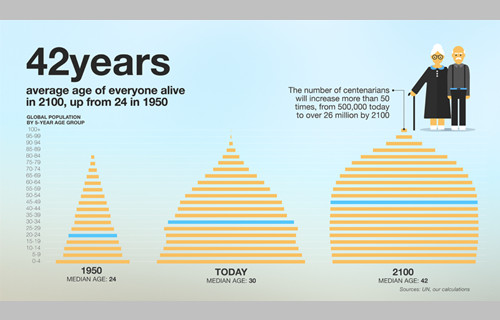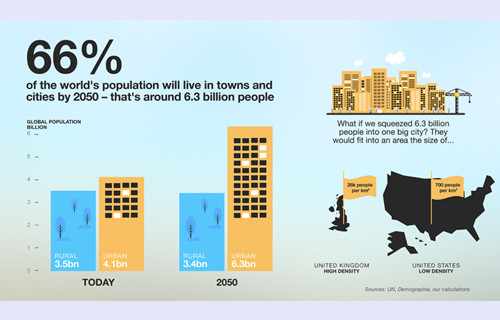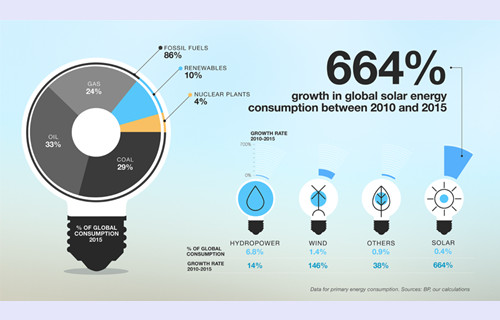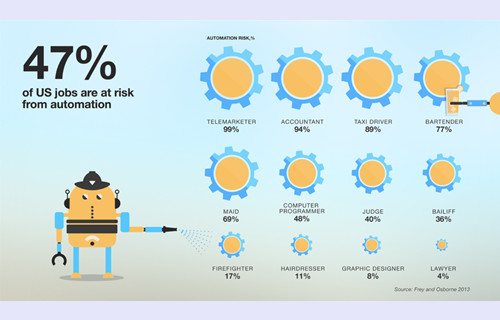导读:人无远虑,必有近忧。未来100年,人类生存的环境将发生翻天覆地的变化。对于未来的5个数据,我们不得不提前知晓,提前思考,提前准备。

How will the world’s population continue to increase?
世界人口将会如何继续增长?
There will be 11.2 billion of us by 2100, according to the UN’s most likely scenario. But this is a projection, not a certainty. There’s an outside chance the world’s population could be as high as 16.6 billion by the end of the century. Or it could be as low as 7.3 billion – that’s fewer people than the 7.5 billion alive today. In all the UN scenarios, though, the population keeps increasing until at least 2050.
根据联合国最新数据显示,到2100年世界人口总数可能会达到112亿。但这只是一种预测,并非确切数字。到本世纪末,世界人口总数达到166亿的可能性微乎其微。也有可能会下降至73亿--这比现在的75亿人口还要少。尽管根据联合国的数据来看,至少在2050年之前,人口数量是呈上升状态的。

Why is the average age rising?
平均年龄为何一直增加?
Because we’re living longer and having fewer children each. In 1950, many people across the globe could not expect to make it to their 50th birthday. Today, average global life expectancy is nearly 72 years and by 2100 it is projected to increase to over 83 years. Longer lives mean more old people, while lower fertility rates mean relatively fewer people are born to replace them: the so-called population pyramid is turning into a beehive.
因为我们的寿命越来越长,而生的孩子却越来越少。在1950年,世界上许多人都不敢想象他们能够过上50岁的生日。如今全球平均寿命将近72岁,而到2100年世界人口平均寿命可能会增加到83岁以上。长寿意味着更多的老年人,同时生育率降低意味着取代他们的新生人口越来越少:所谓的人口金字塔正在变成蜂窝状。

Where will we be living?
我们将生活在哪里?
By 2030, there will be 41 megacities of more than 10 million people. And by 2050, two thirds of us will live in urban areas. Super-dense cities could house everyone on a surprisingly small amount of land. Those 6.3 billion urban dwellers in a city the same density as today’s Mumbai could squeeze onto an area the size of the UK. But spread those people out into a city the density of today’s Atlanta, and the land footprint expands dramatically, to around the size of the US. Keeping a lid on suburban sprawl could be a key priority in the megacities of the future.
到2030年,将出现41个人口超过1000万的特大城市。到2050年,三分之二的人口将会生活在城市里。超密集的城市能够容纳每个人的空间将会变得非常狭小。这63亿的城市居民挤在城市的密度相当于如今的孟买人口挤在英国大小的范围内一样。但如果将这些人口分散到像现在的亚特兰大人口密度一样的城市,那需要的土地得急剧扩张到相当于美国大小的面积。向城郊蔓延将会是这些特大城市未来优先考虑的关键举措。

Where will the world’s energy come from?
世界能源从哪里来?
Today the vast majority of the energy humanity consumes – 86% – comes from fossil fuels. Renewable energy sources account for around 10% of the total, but that share is growing fast. Global solar energy consumption was around 7.5 times higher in 2015 than 2010. In a future dominated by renewables, countries with lots of land on which to site wind turbines and solar panels could find themselves at a distinct advantage.
当今人类消耗的绝大部分能源--86%--来自于化石燃料。可再生能源约占总量的10%,但是这一比例正在快速增长。2015年全球消耗的太阳能约为2010年的7.5倍。在未来,再生能源将占主导地位。那些拥有大片土地,能够安装大量风力发电机和太阳能电池板的国家在这一点上将占明显优势。

How likely is my job to be automated in the future?
将来工作自动化的可能性有多大?
Almost half of US jobs could soon be done by a robot or computer, according to Oxford University researchers. But some jobs are much more likely to be automated than others. Telemarketers, accountants and taxi drivers could see themselves replaced over the next decade or two, while jobs requiring creativity, manual dexterity or empathy could persist for far longer. Future labour markets will have to adapt to the pressures imposed by automation.
牛津大学研究人员表示,在不久的将来几乎一半的工作都会被机器人和电脑来完成。但相比较而言有的工作被自动化的可能性更大。在未来10-20年间,电话销售,会计师和出租车司机等工作将会被取代,而需要创造性、灵活性以及情感共鸣的一些工作将存在得更久一些。未来的劳动力市场将不得不去适应自动化带来的压力。







